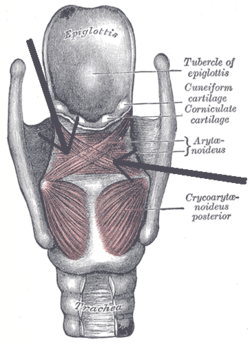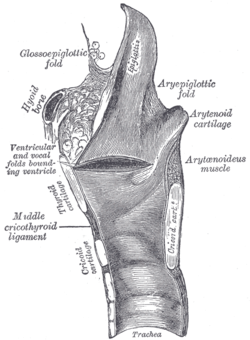- Arytenoid muscle
-
Arytenoid muscle Muscles of larynx. Posterior view.
Oblique arytenoid: The "X" in the center.
Transverse arytenoid: Bands underneath the "X".
Aryepiglotticus: Wraps around back.Sagittal section of the larynx and upper part of the trachea. (Arytenoideus visible at center right.) Latin Arytænoideus Gray's subject #236 1082 Origin Arytenoid cartilage on one side Insertion Arytenoid cartilage on opposite side Artery superior laryngeal artery Nerve recurrent laryngeal branch of the vagus Actions approximate the arytenoid cartilages (close rima glottis) The arytenoid /ærɨˈtiːnɔɪd/ is a single muscle, filling up the posterior concave surfaces of the arytenoid cartilages.
It arises from the posterior surface and lateral border of one arytenoid cartilage, and is inserted into the corresponding parts of the opposite cartilage.
It consists of oblique and transverse parts.
Action
The Arytœnoideus approximates the arytenoid cartilages, and thus closes the opening of the glottis, especially at its back part to eliminate the posterior commissure of the vocal folds.
Additional images
This article was originally based on an entry from a public domain edition of Gray's Anatomy. As such, some of the information contained within it may be outdated.
List of muscles of head and neck: the neck (TA A04.2, GA 4.387) Cervical Suboccipital Suprahyoid CN V3 (medial): mylohyoid · anterior belly of digastric
CN VII (lateral): stylohyoid · posterior belly of digastric
C1 (deep): geniohyoidInfrahyoid/strap Fasciae Pharynx pharyngeal constrictor (superior, middle, inferior) · longitudinal (stylopharyngeus, salpingopharyngeus)Larynx cricothyroid · cricoarytenoid (posterior, lateral) · arytenoid (oblique arytenoid/aryepiglottic, transverse arytenoid) · thyroarytenoid (vocal, thyroepiglottic)Categories:- Muscle stubs
- Muscles of the head and neck
Wikimedia Foundation. 2010.






